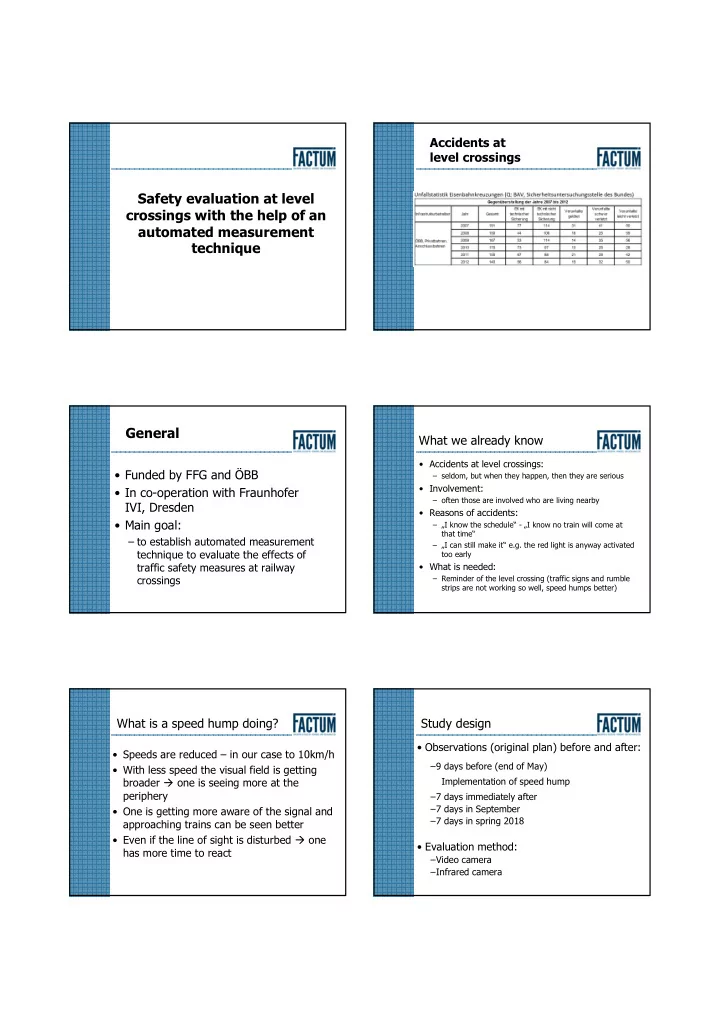

Accidents at level crossings Safety evaluation at level crossings with the help of an automated measurement technique General What we already know • Accidents at level crossings: • Funded by FFG and ÖBB – seldom, but when they happen, then they are serious • Involvement: • In co-operation with Fraunhofer – often those are involved who are living nearby IVI, Dresden • Reasons of accidents: • Main goal: – „I know the schedule“ - „I know no train will come at that time“ – to establish automated measurement – „I can still make it“ e.g. the red light is anyway activated technique to evaluate the effects of too early traffic safety measures at railway • What is needed: crossings – Reminder of the level crossing (traffic signs and rumble strips are not working so well, speed humps better) What is a speed hump doing? Study design • Observations (original plan) before and after: • Speeds are reduced – in our case to 10km/h –9 days before (end of May) • With less speed the visual field is getting Implementation of speed hump broader � one is seeing more at the periphery –7 days immediately after –7 days in September • One is getting more aware of the signal and –7 days in spring 2018 approaching trains can be seen better • Even if the line of sight is disturbed � one • Evaluation method: has more time to react –Video camera –Infrared camera
How do the cameras Infrared camera work • Video camera • Disadvantages: – wave lengths in the visible range for humans – Measurement through glass – records reflections of light (e.g. windscreen) is not possible from a light source on objects – Other details e.g. registration • Infrared camera: plates can not be recorded – working with longer wave length (between infrared and microwaves) • Advantages – records the heat – Less problems with infrared radiation) LH10 data protection of objects (no light source needed) – Possible to measure 24h Installation Kamera 1 Kamera 2 Variables & Hypothesis • Variables: – Type of vehicle – Speeds and braking behaviour – Positions of road users – Looking behaviour – Red light violations – Trains – Conflicts • Hypothesis (with and without speed hump) – Speeds will be reduced – Less often driving against red – Better looking behaviour
Folie 7 LH10 records the heat (infrared radiation) of objects (no light source needed) Lukas Hartwig; 05.10.2017
Evaluation video camera Evaluation infrared camera • Two level segmentation • Based on evaluation sheet – background: – Time quick segmentation between objects – optical flow: – Type of vehicle high computing time, estimation of speed and direction – Speed – Braking behaviour • Combination of both – Looking behaviour • Calculated trajectories can be aggregated into diagrams etc. for: – Red light violations – Speeds – Trains – Braking behaviour – Conflicts – Position of the road user Preliminary results – Preliminary results – infrared camera video observation Sample Size Group Size Preliminary results – Preliminary results – video observation video observation Speed before the level crossing Looking in at least one direction Reduction of speed before the level crossing Driving against red Without 69,8% not recognisable With 68% not recognisable
Summary Next steps • Method is working • Finishing the data evaluation – Speed, position can be evaluated very well • 3rd observation finished in – Some problems with evaluation of the looking behaviour September � base line comparison • Speed hump is working • Introduction of 20 km/h speed limit – Speeds are reduced – Less groups � no following effect • 4th observation – Based on P2W looking behaviour is better • „Problems“ – Maintaining the system – Lots of data from both cameras Thank you!! Questions????
Recommend
More recommend